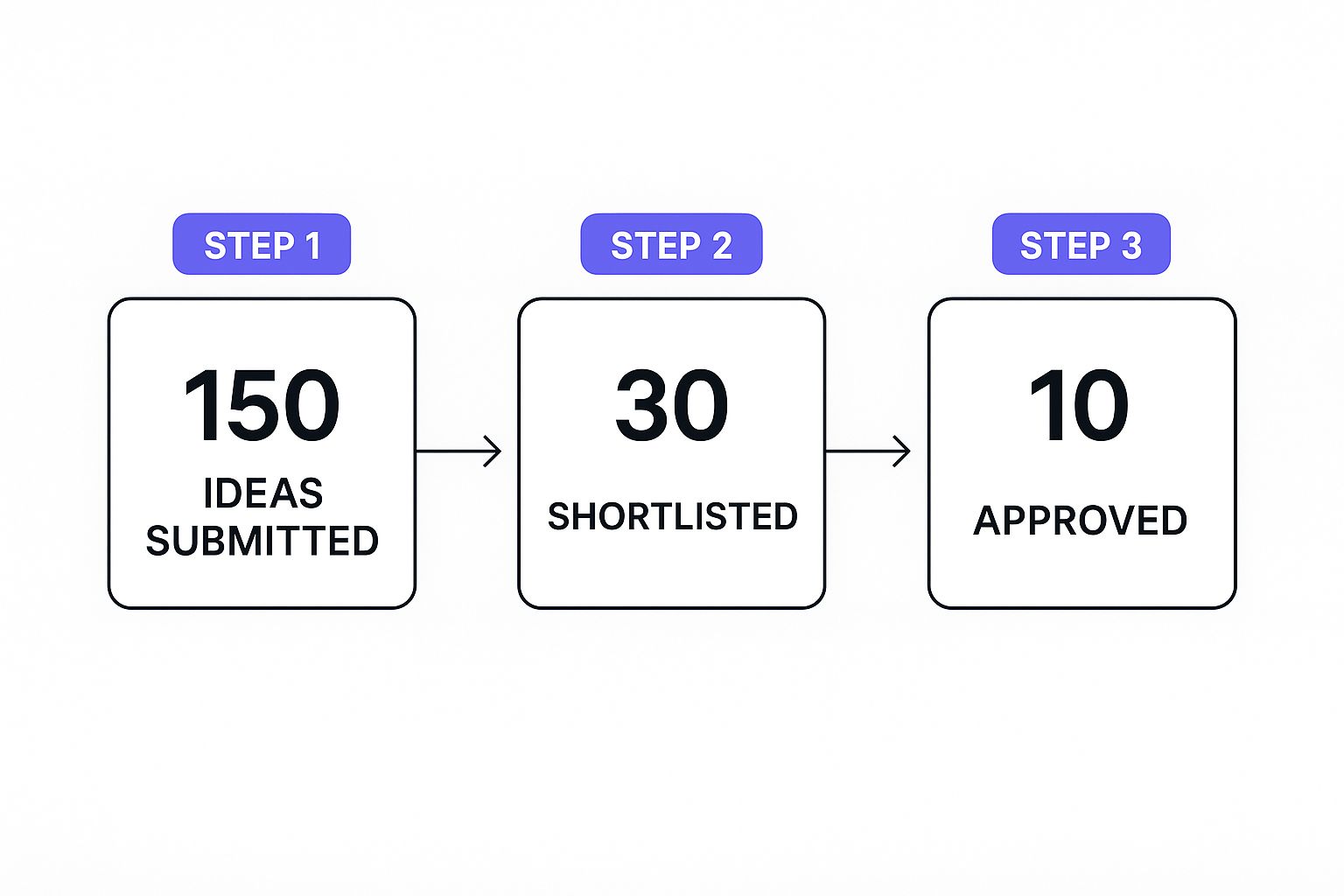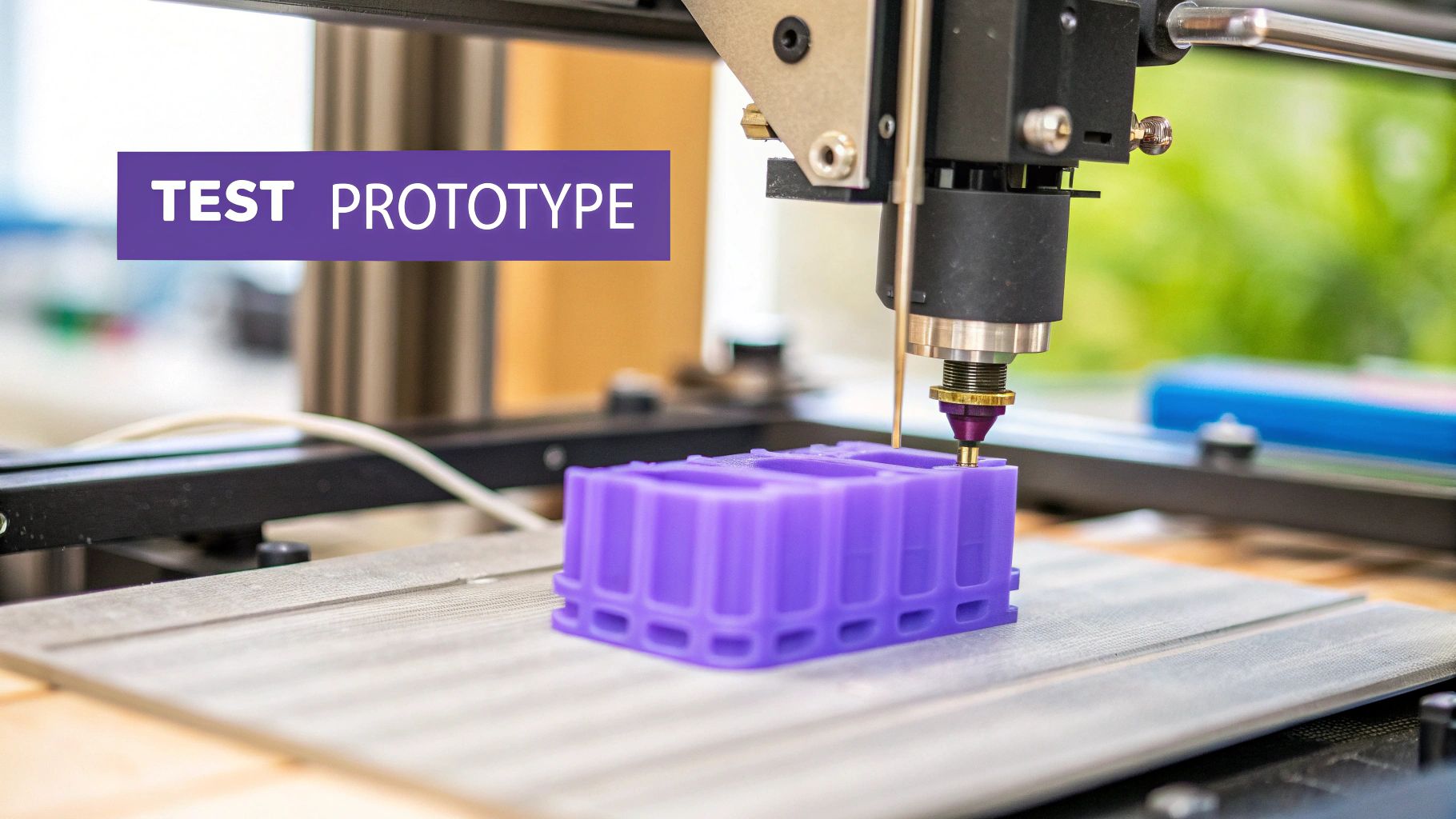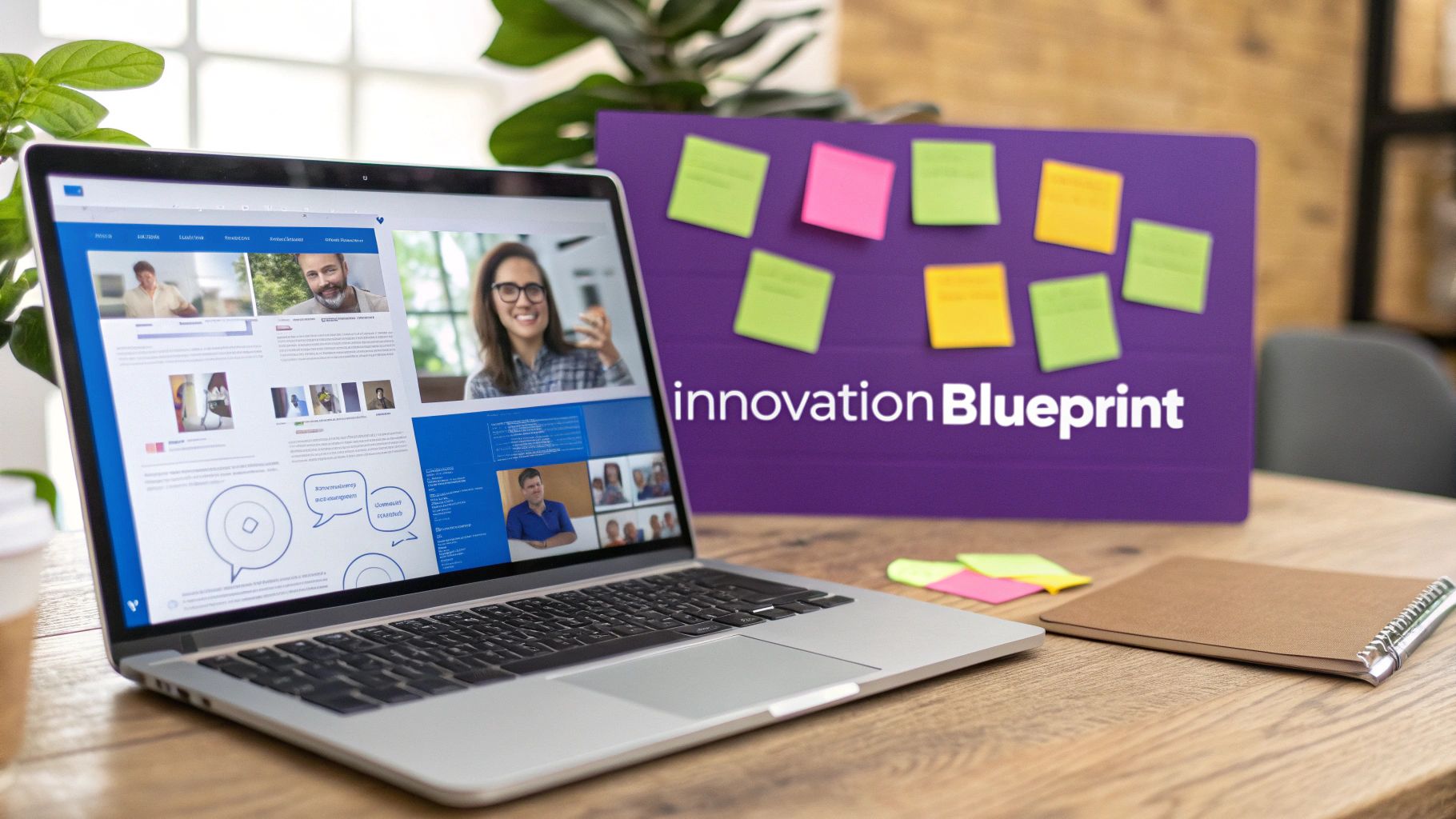So, what exactly is an innovation management process?
Think of it as the recipe a kitchen uses to turn raw ingredients (ideas) into a finished dish (a successful product or service). It’s a structured system that makes sure nothing valuable gets wasted along the way.
What Is an Innovation Management Process Anyway

Let's be honest—the term "innovation process" can sound a bit stiff and corporate. It might bring to mind bureaucratic hoops that kill creativity instead of sparking it. But a good process does the exact opposite.
It creates a reliable pathway for brilliant ideas, keeping them from getting lost in a cluttered inbox or forgotten after a single brainstorming session. For remote teams, where you can't just bump into someone in the hallway, having a clear system is absolutely essential.
An effective innovation management process turns random sparks of genius into a sustainable engine for growth. It provides the clarity and structure needed to move from a cool concept to a real-world result.
From Messy Ideas to Measurable Impact
Without a process, innovation can feel chaotic. A great idea pops up in a Slack channel, but with no clear next steps, it just fades away. Another comes up on a video call, only to be forgotten by the next morning. The whole point of innovation management is to replace that randomness with reliability.
This means creating a clear pipeline that looks something like this:
- Idea Generation: Actively encouraging and collecting ideas from everyone in the company.
- Idea Screening: Sifting through submissions to find the most promising ones based on set criteria.
- Development and Prototyping: Building and testing the best concepts in a low-risk, experimental way.
- Implementation: Launching the validated idea and measuring its impact in the real world.
This structure ensures every promising thought gets the attention it deserves.
An innovation management process isn't about controlling creativity; it's about channeling it. It provides the guardrails that guide ideas from a simple thought to a market-ready solution, ensuring momentum is never lost.
The demand for these systems is skyrocketing. The global innovation management market was valued at USD 1.54 billion in 2023 and is expected to hit USD 2.92 billion by 2030, all because businesses are under huge pressure to innovate faster.
Ultimately, this framework gives everyone a shared language and a clear set of expectations. If you're interested in a more human-centered approach, learning What Is the Design Thinking Process is a fantastic place to start. It helps turn innovation from an occasional stroke of luck into a repeatable, manageable part of your business that delivers real results.
The Four Core Stages of Turning Ideas into Reality
Innovation isn't a single "aha!" moment. It's a journey—a disciplined process that takes a spark of an idea and carefully nurtures it into something real and valuable. Without a clear path to follow, even the most brilliant concepts get lost along the way.
Think of it like a relay race. Each stage is a runner with a specific task, and a smooth handoff between them is what gets you across the finish line first. Let's break down the four legs of this race.
Stage 1: Idea Generation and Collection
This is where it all begins. The goal here isn’t to find the perfect idea; it’s to gather as many different ideas as possible. For remote teams, this means you have to be deliberate about creating places where inspiration can strike and be captured.
Great ideas can come from anywhere. They might be hiding in a customer support ticket, pop up during a virtual coffee chat, or emerge from a deep dive into a competitor's weaknesses. The key is to build channels that actively encourage people to share these thoughts.
A few solid methods include:
- Structured Brainstorming: Run virtual sessions with specific prompts to focus everyone's creative energy on a single problem.
- Customer Feedback Analysis: Systematically dig through surveys, reviews, and support chats to find customer pain points and unspoken needs.
- Innovation Challenges: Launch short-term contests that rally the team around solving a specific business challenge.
At this stage, quantity beats quality. You're casting a wide net to make sure no potential breakthrough slips through the cracks.
Stage 2: Idea Screening and Evaluation
Okay, so you have a big pool of ideas. Now what? It's time to start filtering. This is where you separate the potential game-changers from the well-intentioned distractions. Not every idea can be pursued, and a solid screening process stops you from wasting resources on concepts that don't align with your company's goals.
This isn't about being overly critical; it's about being objective. You're looking for the ideas with the highest potential impact and the most realistic chance of success.
A simple but surprisingly powerful tool for this is the Impact vs. Effort Matrix. You can plot each idea on a simple grid:
- High Impact, Low Effort (Quick Wins): These are your top priorities. They deliver a lot of value without draining your resources.
- High Impact, High Effort (Major Projects): These are the big, strategic bets that need careful planning and serious investment.
- Low Impact, Low Effort (Fill-ins): You can tackle these if you have spare time, but they aren't a priority.
- Low Impact, High Effort (Time Sinks): Avoid these. They’ll eat up resources for very little return.
This visual approach brings immediate clarity and helps teams make decisions based on data, not just gut feelings. The funnel below shows how this narrowing-down process works in practice.

As you can see, the filtering is aggressive. It's not uncommon to see 150 raw ideas whittled down to just 10 approved projects, ensuring the team's energy is focused only on what matters most.
Stage 3: Development and Prototyping
With a short list of promising ideas, it’s time to make them tangible. This stage is all about experimentation and learning. Instead of pouring a ton of money into a full-scale launch, the team creates a prototype or a Minimum Viable Product (MVP).
A prototype can be as simple as a few sketches for a new app feature or a detailed process map for a new internal workflow. The point is to build a low-cost, low-risk version of the idea that you can put in front of real users or stakeholders for feedback.
Prototyping isn't about building a perfect final product. It's about building just enough to learn and validate your core assumptions quickly. Failure at this stage is a cheap lesson, not an expensive mistake.
This back-and-forth feedback loop is at the heart of a modern process for innovation for remote teams, as it allows for quick pivots based on what you learn from the real world.
Stage 4: Implementation and Launch
This is the final leg of the race. Once an idea has been tested and validated through prototyping, it’s ready for a full rollout. This means allocating the budget, assigning a dedicated team, and creating a solid go-to-market plan.
For remote teams, crystal-clear communication and project management are everything here. Everyone needs to be on the same page about deadlines, roles, and what success looks like. The launch isn't the end, either—it's the beginning of a new feedback cycle.
After the innovation goes live, the team needs to track its performance. How are customers actually using it? What's the ROI? This data becomes fresh fuel for the next round of idea generation, turning the innovation management process into a continuous, self-improving loop. It’s no wonder the market for these platforms is projected to grow from USD 1.3 billion in 2023 to USD 2.1 billion by 2028.
Finding the Right Innovation Framework for Your Team

If your innovation process is the roadmap, then your innovation framework is the vehicle you use to travel it. It's the playbook that gives your team a shared philosophy and a set of practical tools to bring those big ideas to life.
You wouldn't use the same game plan for a sprint and a marathon, right? The same logic applies here. Picking the right framework is crucial, especially for remote teams where a clear, shared methodology keeps everyone aligned and moving in the same direction.
Let's break down three of the most effective frameworks and see how they can give your innovation process the structure it needs to thrive.
Open Innovation: Tapping Into a World of Ideas
The core idea behind Open Innovation is simple but powerful: not all the smart people work for you. Instead of trying to solve every problem with your internal team, this framework encourages you to look outside your company’s walls for new ideas, technologies, and perspectives.
It’s about tearing down the classic corporate silo.
This approach feels incredibly natural for remote teams, who are already pros at collaborating across digital and geographical lines. By tapping into a global network of freelancers, universities, or even your own customers, you can access a much richer, more diverse pool of talent than you could ever assemble in-house.
- Who It's For: Perfect for companies in complex, fast-moving industries like tech or biotech that need to crack tough problems fast.
- Key Benefit for Remote Teams: It supercharges the external collaboration skills that distributed teams already possess, dramatically expanding their creative reach.
- Digital Tools: Think collaborative whiteboards like Miro for brainstorming with external partners or specialized platforms for running public innovation challenges.
Open Innovation turns your company from a solitary fortress into a bustling town square. You start actively trading ideas and expertise with the outside world, recognizing that collective intelligence always beats isolated genius.
This framework can seriously accelerate your innovation management process by bringing in fresh thinking and ready-made solutions, saving you a ton of time and R&D money.
Design Thinking: Solving Real Problems for Real People
While Open Innovation looks outward, Design Thinking looks inward—deep into the actual needs and frustrations of your customers. This is a human-centered approach to problem-solving where empathy is king. It’s not about guessing what your users want; it's about systematically discovering what they truly need.
The process usually follows five stages: Empathize, Define, Ideate, Prototype, and Test.
This structured method is a lifesaver for remote teams. Digital tools make it easier than ever to conduct user interviews, map out feedback on virtual whiteboards, and build and test prototypes together, even if team members are thousands of miles apart. It's a fantastic way to build the creative muscles needed for long-term success.
Want to go deeper? You can learn more about how to improve innovation skills with a specific focus on this kind of empathetic, user-first mindset.
The Lean Startup: Building Fast and Learning Faster
The Lean Startup method is all about speed and evidence. Its core philosophy, made famous by Eric Ries, is the "Build-Measure-Learn" feedback loop. Instead of spending ages perfecting a product in secret, you build a Minimum Viable Product (MVP), get it to real users as fast as possible, and use their feedback to decide what to do next.
This framework is a perfect fit for agile remote teams. It swaps out exhaustive planning documents for rapid experimentation and hard data. The entire focus is on validated learning—proving your core assumptions with real-world evidence before you sink a ton of resources into them.
This dramatically cuts down on waste and helps ensure you're actually building something people will pay for.
- Who It's For: Startups and corporate teams navigating high levels of uncertainty, where the risk of building the wrong thing is a major concern.
- Key Benefit for Remote Teams: It creates a shared language around data and experiments, making sure decisions are driven by evidence, not just opinions.
- Digital Tools: Tools like LaunchDarkly for feature flagging and A/B testing or SurveyMonkey for grabbing quick feedback on an MVP are essential.
Comparing Popular Innovation Frameworks
Choosing between these frameworks can be tough. This table breaks down their core differences to help you decide which one makes the most sense for your team's specific goals and challenges.
| Framework | Best For | Key Benefit for Remote Teams | Potential Challenge |
|---|---|---|---|
| Open Innovation | Solving complex R&D problems by tapping into external talent and technologies. | Expands the team's creative reach beyond internal resources without physical boundaries. | Managing intellectual property and building trust with external partners. |
| Design Thinking | Creating user-centric products and services by deeply understanding customer needs. | Provides a clear, structured process for remote collaboration on complex user problems. | Can be time-consuming to conduct in-depth user research remotely. |
| The Lean Startup | Validating new business ideas quickly and efficiently with minimal resources. | Fosters a data-driven culture that keeps distributed teams aligned on what works. | Requires a high tolerance for failure and the ability to pivot quickly. |
Ultimately, the best framework depends entirely on your team’s culture, your goals, and the problem you’re trying to solve. Whether you need outside expertise, a deeper connection with your users, or a way to test ideas quickly, adopting one of these playbooks will bring discipline and focus to your innovation efforts.
How to Manage Innovation with a Remote Team

When your team is spread out, the whole dynamic of innovation changes. Those spontaneous "water cooler" moments or whiteboard sessions that spark brilliant ideas just don't happen. A great thought shared in a Slack message can get buried in minutes.
So, how do you keep the ideas flowing? You have to be deliberate. Managing an innovation management process remotely means replacing random chats with intentional systems—ones that work across different time zones and locations. It's all about creating dedicated, visible spaces where ideas can live, breathe, and grow.
Build a Central Hub for Ideas
In a remote team, an idea that isn't written down might as well not exist. If ideas are scattered across direct messages, email threads, and meeting notes, they’ll eventually fade away. The first, most crucial step is to create a single source of truth for every new concept.
Think of it as a digital suggestion box, but one where everyone can see inside. This "idea hub" needs to be transparent, allowing team members to see what’s been submitted, add their own thoughts, and build on each other's concepts. That visibility is the bedrock of a strong remote innovation culture.
You don't need a fancy, expensive tool to get started. You could use:
- Dedicated Software: Platforms like Bulby or InnovationCast are designed for this.
- Project Management Boards: A simple Trello or Asana board with columns like "New Ideas," "Under Review," and "Prototyping" works wonders.
- Shared Documents: For smaller teams, even a well-organized Google Doc or a Notion page can be a great starting point.
The specific tool is less important than the habit of using it. By creating one designated place for ideas, you make sure no brilliant spark gets lost in the digital shuffle.
Run Inclusive Virtual Brainstorming Sessions
Let's be honest: virtual meetings can easily be dominated by the loudest voice or the fastest typist. To make remote brainstorming actually work, you have to level the playing field. Forget unstructured free-for-alls and use techniques that invite everyone to contribute.
A surprisingly powerful method is "silent brainstorming." Give your team a prompt, then set a timer for 10 minutes. Everyone spends that time quietly writing down their own ideas in a shared space, like a virtual whiteboard or a collaborative doc. This gives the introverts and deep thinkers on your team the space they need to formulate their thoughts without being interrupted.
True remote collaboration isn’t about talking at the same time; it's about thinking together, separately. Structured exercises ensure that the best idea wins, not just the loudest one.
Once the time is up, the team can come together to review, group, and discuss all the ideas that were generated. This simple change in process almost always leads to a richer, more diverse pool of concepts. For more practical tips, check out our guide on fostering innovation in remote teams.
Create a Culture of Psychological Safety
Innovation is messy. It requires people to feel safe enough to share a half-baked idea, question the status quo, or admit an experiment didn't work. Without psychological safety, your team will play it safe, sticking to the predictable options. And that's where true innovation goes to die.
Building this trust is even more critical when you're remote. You can't read the room or rely on body language to gauge how people are feeling. As a leader, you have to actively model vulnerability and celebrate the learning that comes from failure.
Here are a few ways to do that:
- Celebrate "Intelligent Failures": When a smart experiment doesn't pan out, praise the team publicly. Highlight what was learned, not what went wrong.
- Ask for Dissent: In meetings, make a point to ask, "What are we missing here?" or "What's the argument against this idea?" This normalizes constructive pushback.
- Use Blameless Post-Mortems: When a project fails, the focus should always be on "what happened" and "what we can learn," never on "who is to blame."
Creating a safe space is the foundation of any successful remote innovation management process. And it pays off. Despite economic uncertainty in 2023, the gains from innovation have continued to rise. According to WIPO.int, output per worker grew from around USD 43,000 in 2012 to USD 51,000 in 2023. This shows that getting innovation right is a powerful way to drive efficiency, even when times are tough.
Real-World Examples of Innovation Done Right
Talking about frameworks and stages is one thing, but the real lightbulb moments happen when you see an innovation management process out in the wild. Theory is great, but it’s the stories of how real companies—both massive and small—turn sparks of inspiration into something tangible that truly show us what’s possible.
These examples connect the dots between having a structured system and getting real-world results. They prove that innovation isn't just about waiting for a lightning bolt of genius; it's about building a machine that can catch lightning in a bottle, again and again.
So, let's pull back the curtain and see how some of the most innovative companies on the planet actually do it.
Google's Legendary 20% Time
One of the most well-known examples of baking innovation right into the company culture is Google's famous "20% Time." For a long time, Google flat-out encouraged its engineers to spend 20% of their paid time—basically a full day each week—working on whatever they wanted, as long as it wasn't their main project.
This wasn't just some feel-good perk; it was a deliberate, structured part of their innovation engine. The policy handed employees the freedom to chase down personal passions and curiosities, all built on the trust that this autonomy would eventually lead to big things.
And did it ever. This simple but incredibly powerful system gave birth to some of Google's most iconic products:
- Gmail: What began as a side project is now one of the most dominant email platforms in the world.
- AdSense: This advertising tool completely changed online monetization and became a monster revenue stream.
- Google News: An engineer’s idea to use algorithms to round up news stories grew into a global service.
Google’s 20% Time perfectly illustrates a core principle of great innovation management: You have to intentionally create the space for exploration. If you don't carve out the time and give people explicit permission to tinker, most brilliant ideas will simply die on the vine.
This approach didn't just hope for ideas; it made generating them a regular, expected part of the job.
Amazon's Working Backwards Method
Amazon's innovation process is famously, relentlessly customer-obsessed. Before anyone on a team writes a single line of code or designs a single mockup, they have to follow a strict method called "Working Backwards."
It all starts with the finish line. The product manager has to write an internal press release announcing the final, shipped product. This document isn’t for the public; it’s an internal tool to force absolute clarity. The press release has to sound exciting to a customer and make it painfully obvious what problem it solves.
If the press release falls flat or the customer benefit feels fuzzy, the idea gets sent back to the drawing board or scrapped entirely. Only when the vision is perfectly clear does the project get the green light. This simple trick prevents teams from wasting months building something nobody actually wants.
For a look at other approaches, you can explore these innovation process examples to see how different companies solve the same problem.
Innovation in Smaller Remote Teams
You don't have to be a tech titan to build a killer innovation process. Many smaller, fully remote companies are using lean principles to stay nimble and punch well above their weight. In fact, understanding the digital transformation for small business shows how innovation is the engine of growth, no matter the company's size.
For example, imagine a small remote SaaS company. They might use a simple Trello board to manage their idea pipeline. Every idea, whether from a customer support ticket or a team brainstorm, gets dropped into a "Backlog" column.
Once a week, a small, cross-functional "innovation squad" gets together. They review the backlog and drag the most promising ideas into a "To Validate" column. From there, they run small, fast experiments—maybe they’ll spin up a landing page to see how many people sign up, or they’ll interview five customers about a specific pain point.
This lean, data-first approach lets them test ideas without betting the farm. It’s a perfect example of an innovation management process built for an agile, distributed team that needs to move fast.
Common Questions About Innovation Management
As you start piecing together your own innovation management process, you're bound to run into a few common questions. Let's be honest, some of this can feel a little abstract at first. Getting clear on these points is the key to getting your team on the same page and moving forward with confidence.
Think of this as a quick FAQ to clear the air on the most frequent sticking points.
What Is the Difference Between Innovation and Project Management?
This one trips a lot of people up because, on the surface, they look similar. Both involve teams, tasks, and getting something done. But their fundamental goals are worlds apart.
Here’s a simple way to think about it: imagine you need to cross a massive canyon.
Project management is like being handed a detailed blueprint for a bridge. Your job is to follow that plan perfectly—managing the resources, timelines, and risks to build that specific bridge as efficiently as possible. The whole game is about predictability and control. You know exactly what you’re building, and success means delivering it on time and on budget.
Innovation management, on the other hand, is about asking, "Should we even build a bridge?" Maybe a zip line would be better. Or a catapult. Or maybe we don't need to cross at all! Its entire purpose is to explore the unknown and figure out the right plan in the first place. It’s a messy, creative process of learning and validation, where the real goal is to find a breakthrough, even if it means a few experiments don't pan out.
Innovation management is the architect trying to invent the best way to cross the canyon. Project management is the construction crew that takes the final blueprint and builds it flawlessly.
You absolutely need both, but they solve very different problems. One is about executing a known plan perfectly; the other is about discovering a new one.
How Can a Small Business Implement This Without Expensive Tools?
This is probably the biggest myth holding smaller teams back. You do not need a massive budget or a suite of enterprise software to build a culture of innovation. The real power comes from the habits you create, not the tools you buy.
In fact, you can stitch together a surprisingly effective system using tools you’re likely already paying for.
- For Gathering Ideas: Start a dedicated channel in Slack or Microsoft Teams called
#ideas. It's free, it's right where everyone already works, and it makes submitting an idea feel effortless. A shared Google Doc or Notion page works great, too. - For Vetting Ideas: Fire up a virtual whiteboard like Miro or Mural. You can quickly build an impact vs. effort matrix to visually sort and prioritize ideas with your team, no complicated software needed.
- For Getting Feedback: Need to see if an idea has legs? Use free tools like Google Forms or SurveyMonkey to poll your customers and get real-world validation without spending a dime.
The goal isn't to buy a perfect system on day one. It's to create the habit of capturing, discussing, and testing new ideas systematically. Start simple, prove the process works, and then you can think about dedicated tools. To see how these early steps fit into the bigger picture, you can explore these essential innovation process steps in our guide to successful innovation.
How Do You Measure if an Innovation Process Is Actually Working?
Measuring innovation can feel like trying to nail Jell-O to a wall. You're often dealing with long-term bets, so how do you know if you're on the right track today? The trick is to track a mix of metrics that show the health of your process and its eventual business impact.
Think of it like tending a garden. You have to check the health of the soil and the sturdiness of the young plants (leading indicators), not just wait around to count the final harvest (lagging indicators).
Leading Indicators (Is the Process Healthy?)
These numbers tell you if your system is actually being used and creating momentum. They're the early warning signs that tell you if you're headed in the right direction.
- Number of ideas submitted per month: Is the well running dry or overflowing?
- Employee participation rate: Is it just the same three people, or is the whole company engaged?
- Percentage of ideas prototyped: Are you actually trying things, or just talking about them?
- Time from idea to decision: How fast are you moving? A quick "no" is better than a slow "maybe."
Lagging Indicators (Is It Delivering Value?)
These are the bottom-line results that show up later. They prove that all that creative effort is actually moving the needle for the business.
- Revenue from new products launched in the last 24 months: Is innovation driving real growth?
- Cost savings from new internal processes: Is it making you more efficient?
- Increase in customer satisfaction or retention: Are your new ideas making customers stick around?
When you track both, you get the full story. Healthy leading indicators are the best predictor of great lagging indicators down the road. A strong process will, sooner or later, produce strong results.
Ready to stop letting great ideas slip through the cracks? Bulby provides a guided, structured platform designed specifically for remote teams to generate, refine, and act on their best concepts. Transform your virtual collaboration and build an innovation engine that drives real results. Learn more and get started with Bulby today!

